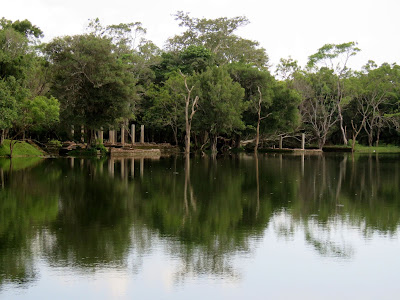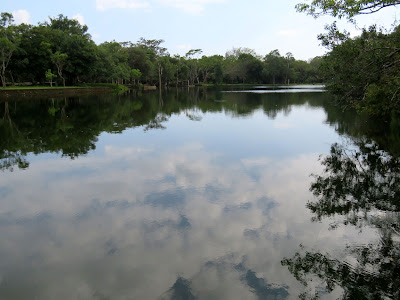
Abhayagiri Monastery was established in 2nd century BC by King Vattagamini Abhaya who was commonly known as King Valagamba. During its glorious days, Abhayagiri was not only a complex of monastic buildings but also a great seat for learning and a flourishing center where Buddhist monks fraternized and disciplined the Sangha's life in the traditional way. Under the reign of King Gajabahu I between years 113 to 135, Abhayagiri Monastery began to gain its fame and an important seat in the nation. It gradually developed into an international leading institution of Buddhism attracting scholars from all over the world. The Chinese famous monk Rev. Fa-Hsien visited the center in year 412 and stayed there for two years to copy texts to bring back to China. Basing on his written records, the great historical Buddhist Center was a multi storied magnificent monastery gilded in gold and roofed with brilliant glazed tiles. The building complex contained elaborate ponds, decoratively carved balustrades and moonstones and was surrounded by walls. The monk also mentioned that during his visit, there were 5000 monks residing in the complex.


Abhayagiri Monastery was named after King Vattagamini Abhaya and the Jain Priest Giri who insulted him when he fled from Anuradhapura after the capital fell in the hand of Indian Tamil invaders. The King fulfilled his vow after re-gained his kingdom and built the monastery with stupa at the site of the Jain's hermitage. Abhayagiri Monastery thus is not only a symbol of religion but also a national resurgence. It marked the end of Brahim and Jain influences in the country.



The Elephant Pond Eth Pokuna in Abhayagiri monastery complex was the largest man-made pond built in the ancient Sri Lanka. The rectangular pond measured at 150 meters in length by 50 meter in width and 10 meter in depth was built in 3rd century. Its cistern sluice and conduit that channeled water to the refectory of monastery were found at site.


The site of Abhayagiri Monastery and its Eth Pokuna were hidden in a greenery wooded forest, which now are homes to the wilds.


Remains of The refectory and four phases construction dated from 1st century BC that had been mentioned in the inscription of King Kassapa V (914-923) in 10th century was discovered.


The remains of its kitchen, store rooms and the underground conduits supplying water from Eth Pokuna pond to the buildings were found at site.


Unlike Mahavihara of that era who only accepted the practices of Theravada, Abhayagiri Monastery encompassed all versions of Buddhist teachings including Theravada and Mahayana. Abhayagiri monks were opened to various schools of Lord Buddha's philosophies and teachings. Today, the extensive ruins of this major monastic site of Theravada and Mahayana Buddhism in the ancient city of Anuradhapura had become one of the most sacred pilgrimage sites to all Buddhists.


The huge 19 meters long trough cut into a shape of a boat from a stone was used to contain rice serving lunch for 5000 monks at the monastery. All monks traditionally only allowed to have solid food before noon. The vessel-like trough made it faster and easier for monks to have their lunch as they could stand on both sides to have their food served.




The smaller ones along the side are believed to be for gruel.


The structure built to include a rock was a type of Studa belong to late Anuradhapura era, known as Satmahal Prasada. Similar structure could be found in Thailand.


Ruins scattered around a huge wooded greenery site.



The Burrow's Pavilion was named after the person who restored the entrance porch to Buddha Tree Shrine. Rules and regulations of Abhayagiriya Monastery were inscribed on the stone slab at the precinct. It could be attributed to King Kassappa (914-923) and King Mahinda IV (956-972).



The replica of a sun dial stone tablet that was used for measuring the movement of sun was found at the eastern side of the ruins. The original unearthed sun dial was displayed at the Abhayagiri Museum.


Water supplied from a man-made pond to refectory of Abhayagiri Monastery was through the cistern sluice and conduit which are still existing at site.




This was the most ancient Bodhi Tree Shrine of Abhayagiriya mentioned by the Chinese Monk Rev. Fa-Hsien when he visited the monastery in 5th century. As his record, it had four Buddha images enshrined at its four sides.



The seated portrait of Buddha Image on a Vajrasanas sacred seat dated back to 1st century BC was the only one survived at site. Remains of others and the square pit where the Bodhi tree was planted, were found around the area. It was recorded that the original tree of the Bodhi Tree Shrine was from a seedling of Jayasrimaha Bodhi Tree of India.


It is indeed a great blessing to have come here, bowing and paying homage to the thousands years Buddha Image of a great monastery. No mat, no cushion, kneeling on the coarse sandy ground, what was in mind at this moment was the true devotion of a sincere Buddhist.



An aged Sal Flower tree flourished near the Bodhi Tree Shrine.


Abhaya Wewa was one of the man made reservoirs built to collect rain water for the irrigation to the agricultural districts of Anuradhapura ancient city in the past.


Great Credits to the ancient monarchs of the island. The reservoirs they made not only continue supplying water for needs but also create homes to the wild life.





No comments:
Post a Comment